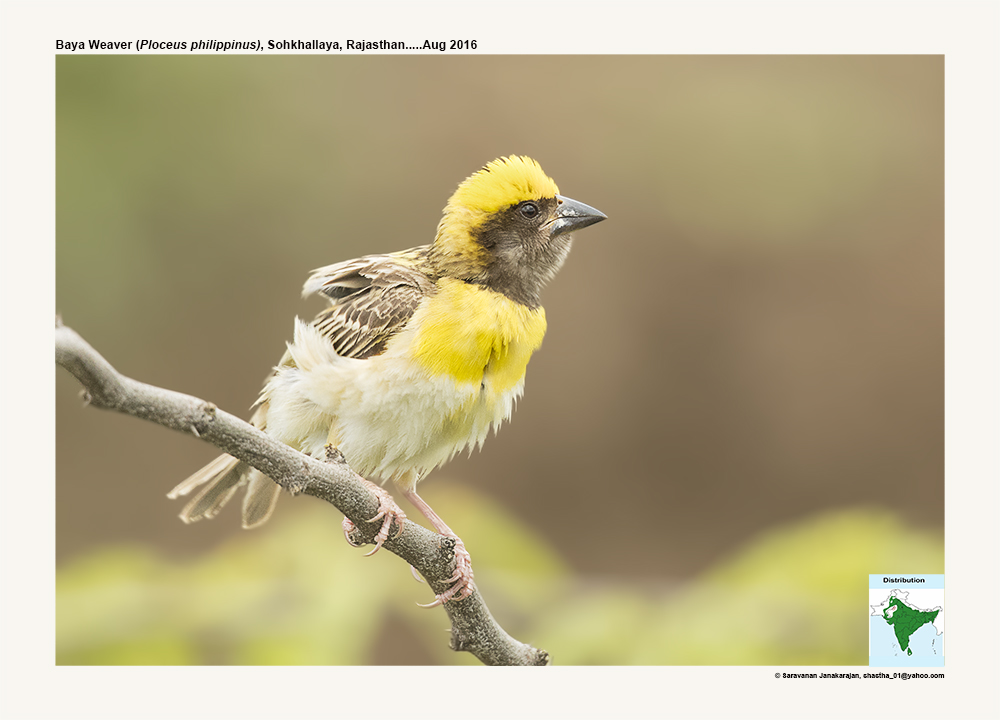
Baya Weaver Ploceus philippinus
Etymology :
- Ploceus : Greek word plokeus – weaver, braider, plaiter derived from pleko – to plait, to entwine
- Philippinus : From Philippines
Vernacular Names : Hindi: Baya, Son-chiri, Pun: Bijra, Baya, M.P.: Suyam, Ben: Babui, Ass: Tookora sorai, Cachar: Dao-tiri-bhai, Guj: Baya sugari, Mar: Sugran, Gavlan, Vinkar, Ta: Thukanan-kuruvi, Thonga-nathan, Tokora sorai, Manja-kuruvi, Te: Pasupu pitta, Mal: Attakkuruvi, Kan: Nekara pakshi, Sinh: Wadu-kurulla, Tatteh-kurulla, Goiyan-kurulla
Distribution in India: Widespread resident in India.
Description: size of 15 cm; wt. of 18–28 g. It is a medium-sized weaver. The male of nominate race during breeding has yellow on forehead and crown becoming browner on nape, with mantle and back feathers dark brown fringed yellow, rump is light brown with faint streaks. The upperwing and tail are brown, remiges are with narrow yellow margins, and wing-coverts are with buff margins. The lores, cheek, ear-coverts, chin and throat are dark chocolate-brown, this colour extending as bib onto upper breast; rest of breast is yellow. The flanks are cream with some faint dark central streaks, belly, thighs and undertail-coverts are creamy white; iris is brown; bill is black; legs are brown. The male non-breeding and female have brown forehead, crown, nape and back with dark central streaks. The streaking is broadest on mantle, rump is light brown with faint streaks; wings and tail are brown. It has pale edges on remiges and broader edges on wing-coverts; broad buffy supercilium; lores, cheek and ear-coverts are light brown, chin and throat are white, buffy wash on breast and flanks and some streaking on side of breast and flanks. The belly, thighs and undertail-coverts are whitish; upper mandible is light brown to yellowish, lower mandible is horn-coloured to mostly yellow. The juvenile resembles female, but with fainter dorsal streaking, upperparts are rusty buff with broad rusty margins on wing-coverts, no obvious supercilium, cheeks are buffy and general buffy wash on underparts.
Habitat: It is found in grassland, scrub with scattered trees, mangroves and cultivated areas, open country near water. Found from lowlands to 1400 m.
Food habits: It eats seeds, cultivated rice, wheat, maize, sorghum, millet, sunflowers, nectar, and insects like grasshoppers, flies, termites, beetles, caterpillars and butterflies, spiders, small snails. Bigger prey like rice frogs are battered on perch and then eaten piecemeal. Gecko and changeable lizard are fed to nestlings. The adults are primarily granivorous, with rice often the most important food item. They are gregarious. They are found often in association with other species, starlings, waxbills, sparrows, wagtails and bulbuls.
Breeding habits: They breed in May–Sept in Pakistan, Apr–Oct in India, Mar–Apr and Aug–Sept in Sri Lanka; Dec–Jun in SE Asia, Jun–Aug in Myanmar, Apr–May in S Laos and Mar–May in Java. The duration of breeding may be influenced by growth of rice plants. They are double-brooded. They are Polygynous, with 3–5 females per male. They are colonial, with up to 60 nests in single tree and more than 200 in some colonies, sometimes in mixed colonies with other weavers and highly territorial. The nest is retort-shaped, with pendulous supporting section and usually long entrance tunnel, woven by male from strips of palm, grass or rice-plant leaves. The male starts with wad of material woven around supporting branch, works downwards from this to form thick woven strap, at base of which he constructs a ring and then, perched on ring, completes the “helmet stage” (which resembles a helmet with a chinstrap), adding blobs of mud, sometimes cattle dung, to structure at this stage ( for reinforcement). The nest completed only if accepted by female, male then builds the nest bowl, female sometimes participates by bringing lining material of fibres and a few feathers; entrance to the tunnel is built last, and is very long. The nest is placed above ground or water. They lay a clutch of 2–5 eggs. The incubation is done by female and incubation period is 14–15 days. The chicks are fed by female, some males assist in later stages. The adults may feed through opening direct to nest-bowl, not entering through tunnel each time. The nestling period is 13–23 days. The fledglings fed by both sexes, for up to 14 days. The nest is prone to predators like snakes, corvids, bonnet macaque and changeable lizard .The nest destruction by humans is the most important source of brood loss.